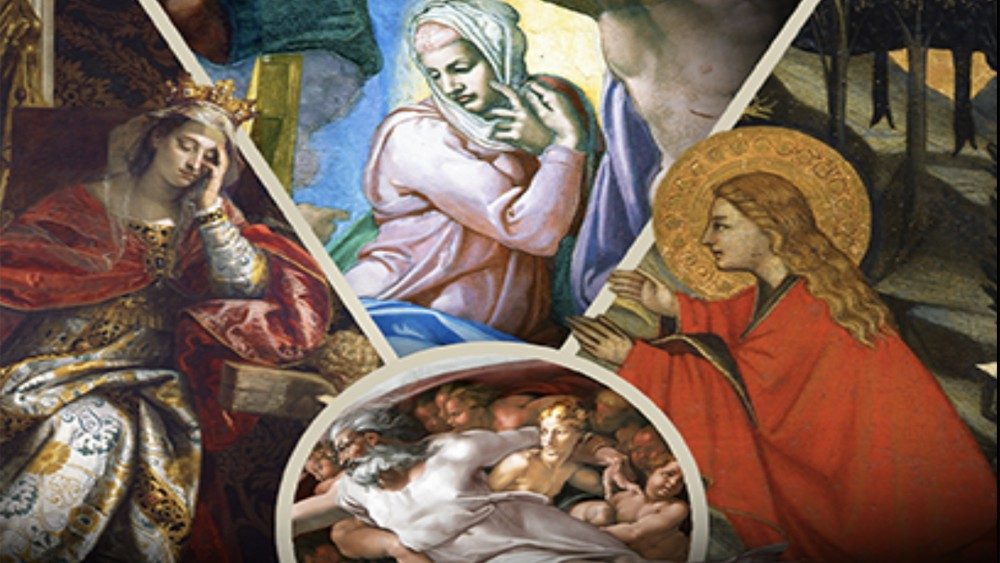Women’s Day: Vatican Museums art celebrates the ‘female genius’
Paolo Ondarza - Vatican City
Mary Magdalene, St. Scholastica, St. Helena, St. Catherine of Siena, and the Virgin Mary: exemplary models of womanhood. There are many women in the Church’s history who, still today, serve as inspirations through their lives of holiness.
Painters throughout the centuries have dedicated some of their most significant pieces of art history to these women.
She who makes the world beautiful
Beginning with Pope Francis' words that "woman is the one who makes the world beautiful," the Vatican Museums are offering for the first time a special itinerary dedicated to International Women's Day: a guided tour to discover the many extraordinary women who have contributed significantly to the life of the Church.
The visit starts at the Pius-Christian Museum, passes through the many iconographic representations of women that populate the Vatican Museum’s Art Gallery, and culminates at the theological and artistic pinnacle of the Sistine Chapel.
Three dates are open to all: the first one was held last Saturday, while the next two dates are scheduled for March 8 and 11. It is possible to book the visit by emailing education.musei@scv.va.
Beauty that attracts eyes and heart
"Women make the world beautiful. This wonderful phrase from Pope Francis is true," Sister Emanuela Edwards, head of the Office of Educational Activities at the Vatican Museums, explains to Vatican News, "Sensible beauty, like that in art, attracts the eyes and the heart. Seeing the lives of saints depicted in artistic masterpieces can become a means of inspiring us to imitate them. International Women's Day is an opportunity to be inspired by the women of the Church throughout time."
[ Photo Embed: Vision of Saint Helena (Dream of Saint Helena) by Paolo Caliari known as the Veronese ©Vatican Museums]
"The artist," Sister Emanuela continued, "painted a Cross supported by an angel in such a way as to make visible the sovereign's dream. At the age of 78, Helena went to the Holy Land to Calvary and, after excavations there, found the true Cross of the Lord. We can therefore think of this powerful woman as the first archaeologist of the Church."
St. Catherine, the Church’s first influencer
Taking us back about 150 years is the Florentine School tempera depicting "Saint Catherine Freeing the Young Lorenza from the Devil," from between 1440 and 1450.
The work exalts a particularly significant figure for understanding the role of women in the Church. "Catherine in fact," recalls Sister Emanuela, "exerted her influence to encourage Pope Gregory XI and the papal court to return to Rome from Avignon. A woman of great virtues, she lived animated by an intense life of prayer, which enabled her to become a spiritual mother to so many people who turned to her."
A courageous woman then who "was not discouraged even in the face of her limitations." The fact that she could not write for example, notes Sister Emanuela, did not prevent her from "having 380 letters written under her dictation to the most influential people of her time. St. Catherine is a great example for the women of today: she changed the society in which she lived by her example and, therefore, belongs to that charismatic side of the Church that, guided by the Holy Spirit, works to accomplish God's will in society. We can define her as the first influencer of the Church."
Mary, a model for every woman
The tour concludes in the presence of the marvelous Michelangelo frescoes in the Sistine Chapel: "We begin with Creation: the story of how God made man and woman so that they would have equal dignity. We conclude with the Last Judgment where we meet Our Lady, depicted as the new Eve, alongside her Son. The Virgin," the nun adds, "is the perfection of femininity that women can be inspired by.
Pope Francis: a woman is the one who makes the world beautiful
Guided tours are in Italian or English and are open to everyone, from families with children to people with sensory, motor and intellectual disabilities.
At the end of the tour one becomes more aware of how the history of the Church is rich with the contribution of so many women. "There are many ingredients that make up female genius. In the Last Judgment," Sister Emanuela Edwards concludes, "there are many unknown women who are, however, saints. The truth is that many women earn their sainthood by contributing their best to the service of family, society and the Church. Today we remember all women and give thanks for every single woman who contributes to the life of the world."
Thank you for reading our article. You can keep up-to-date by subscribing to our daily newsletter. Just click here
















